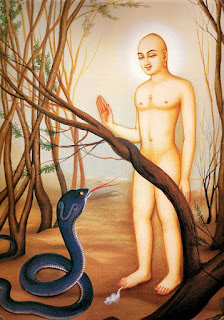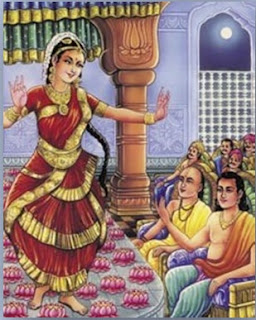||NANDISEN MUNI||
||नन्दिसेन मुनि ||
|| नन्दिसेन मुनि जैन धर्म कहानी ||
||JAIN RELIGION ||
 |
| Sage Nandisen helping and serving the old monk |
Sage Nandisen was a great ascetic and well versed in the scriptures. He took a vow to serve other monks with utmost devotion. His devotion in serving the monks was popular even in the heavenly abode. One day, Indra commended his services during an assembly of demigods. One of the demigods was surprised at such high praise for a mere mortal. Therefore, he decided to see the worthiness of sage Nandisen.
The demigod arrived at the outskirts of the village and assumed the form of two monks, one very old and injured and the other young and healthy. Sage Nandisen had just returned from collecting Gochari (alms) and was about to break his fast when the young monk came to him and said, “Oh blessed one! There is a very old monk suffering from diarrhea, extreme thirst, and hunger. He is weak and needs your help.”
Hearing these words, sage Nandisen immediately got up, took clean water, and went to the old monk. Seeing Nandisen, the old monk raged, “Oh, you wretch! I am lying here suffering and you did not even care to see if anyone needs help.”
Sage Nandisen was not offended by these words due to his virtues of tolerance, forgiveness, and compassion. He calmly replied, “Oh, the best of monks, kindly excuse my oversight. I have brought clean water for you to drink.”
He helped the old monk drink the water, and then cleaned his clothes, his body, and helped him sit up. The old monk again became irritated. He frowned, “Oh, you fool! do you not see that I am too weak to sit? What are you doing to me?”
Sage Nandisen replied politely, “I will help you.” After helping the old monk to sit up, he said, “Oh revered monk, if you desire, I shall carry you to the upäshray (a place where monks stay temporarily) where you will be more comfortable.”
The monk replied, “Why are you asking me? You may do so if you wish.”
Sage Nandisen therefore seated the monk on his shoulders and slowly proceeded towards the upäshray. He walked slowly, watching every step carefully. The demigod was determined to test him, so he gradually increased the old monk’s weight. With the increased weight on his shoulder, sage Nandisen began to tremble and he almost fell. The old monk said, “Oh, you wretch! what is wrong with you? Don’t you know how to walk? You are shaking my entire body. Is this the way to serve the sick?”
In spite of these harsh words, sage Nandisen was not disturbed at all. He said, “Pardon me. I shall be more careful.”
Ignoring the monk’s comments, he continued walking, and took care not to offend the monk any more as a result of his actions. On the way, he thought of ways to cure the monk. During all this, the old monk was watching Sage Nandisen and did not see any change in the helping nature of the sage even after all the aggravation. When they arrived at the upäshray, the old monk turned back into an angel and bowed down at once to sage Nandisen, saying,“You are blessed. Oh sage, you are the illustration of a real monk. You deserve all the praise given by Indra. I am very pleased with you and will grant you whatever you wish.”
“Oh heavenly angel, this human life is very precious. Nothing is more valuable than human existence. I am content. I crave for nothing,” said sage Nandisen. The heavenly angel bowed his head at the feet of the sage and returned to his abode, applauding the merits of the sage.
The demigod arrived at the outskirts of the village and assumed the form of two monks, one very old and injured and the other young and healthy. Sage Nandisen had just returned from collecting Gochari (alms) and was about to break his fast when the young monk came to him and said, “Oh blessed one! There is a very old monk suffering from diarrhea, extreme thirst, and hunger. He is weak and needs your help.”
Hearing these words, sage Nandisen immediately got up, took clean water, and went to the old monk. Seeing Nandisen, the old monk raged, “Oh, you wretch! I am lying here suffering and you did not even care to see if anyone needs help.”
Sage Nandisen was not offended by these words due to his virtues of tolerance, forgiveness, and compassion. He calmly replied, “Oh, the best of monks, kindly excuse my oversight. I have brought clean water for you to drink.”
He helped the old monk drink the water, and then cleaned his clothes, his body, and helped him sit up. The old monk again became irritated. He frowned, “Oh, you fool! do you not see that I am too weak to sit? What are you doing to me?”
Sage Nandisen replied politely, “I will help you.” After helping the old monk to sit up, he said, “Oh revered monk, if you desire, I shall carry you to the upäshray (a place where monks stay temporarily) where you will be more comfortable.”
The monk replied, “Why are you asking me? You may do so if you wish.”
Sage Nandisen therefore seated the monk on his shoulders and slowly proceeded towards the upäshray. He walked slowly, watching every step carefully. The demigod was determined to test him, so he gradually increased the old monk’s weight. With the increased weight on his shoulder, sage Nandisen began to tremble and he almost fell. The old monk said, “Oh, you wretch! what is wrong with you? Don’t you know how to walk? You are shaking my entire body. Is this the way to serve the sick?”
In spite of these harsh words, sage Nandisen was not disturbed at all. He said, “Pardon me. I shall be more careful.”
 |
| Heavenly beings praising the act of Sage |
“Oh heavenly angel, this human life is very precious. Nothing is more valuable than human existence. I am content. I crave for nothing,” said sage Nandisen. The heavenly angel bowed his head at the feet of the sage and returned to his abode, applauding the merits of the sage.
This story teaches us the importance of tolerance, discipline, and contentment which are all fundamental values of Jainism. First and foremost, sage Nandisen chose to devote his life to serving monks, an admirable goal requiring the utmost level of dedication and discipline. He demonstrated his tolerance and willingness to serve others without knowing that the demigod was testing him. This means that he was truly dedicated to monks and believed in what he was doing. He also indicated his contentment with the human life when asked for a wish. This contentment is symbolic of the principle of non-possessiveness.
CLICK ON THE LINKS BELOW IF YOU ARE INTERESTED.
IF YOU ARE INTERESTED IN LIST OF ALL THE SONGS TO DOWNLOAD JUST CLICK THE BELOW HIGHLIGHTED BUTTON TO DOWNLOAD FROM GOOGLE DRIVE
to download it
JAINAM JAYATI SHASHNAM










